Marine Life & Conservation
Pierre-Yves Cousteau’s Galapagos: Final Dives

Read Part 2 of Pierre-Yves’ Galapagos blog here.
One week in San Cristobal followed by a second diving expedition. Nothing scheduled but sunsets the first week. The waterfront of San Cristobal is forever bathed in the pungent smell of sea lion body odour. The Loberia and Punta Carola offer beautiful waves and vast spaces of peaceful wilderness. With nothing else to do, I decide to investigate further the establishment of the new marine sanctuary of Wolf and Darwin and its impact on the local population.

I make my way to the Loberia, a beautiful rocky coast with beaches and powerful waves, to watch the sunset. I take a taxi to go there and back and ask the cab driver about the new sanctuary. He says many families on San Cristobal are fishermen, and that some of them used to go to Wolf and Darwin. He says there was a fishermen’s protest in the village that very morning in town. They are claiming their right to fish in Wolf and Darwin. He says that the three representatives of the fishermen cooperatives signed the agreement to make the sanctuary without consulting with their peers. He mentions rumors of bribery.
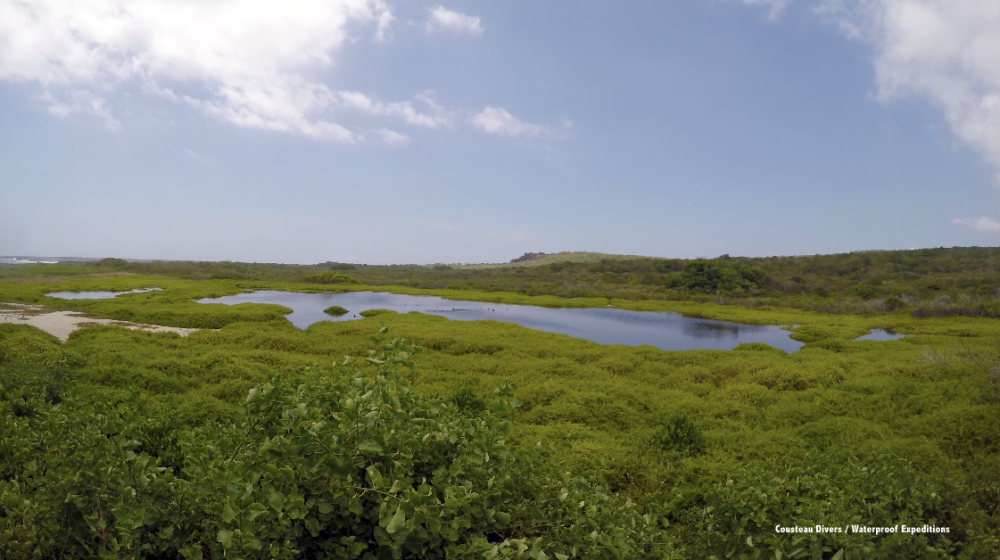
I head to the mayor’s office to get his opinion about the new sanctuary. He says the sanctuary was imposed onto the fishermen, that they were not sufficiently consulted or compensated, and that they should be considered in these kinds of decisions. Regarding tourism in general, he says he wishes the marine activities related to the sanctuary benefitted the people of the islands more than they do, implying that foreign companies capture much of that value.
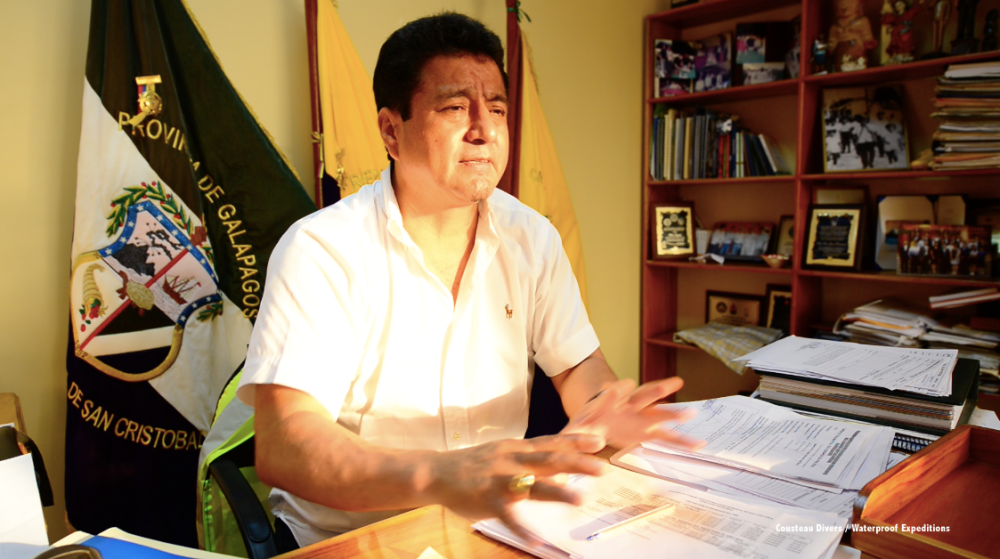
The next day I have lunch with Roberto Ochoa, a conservationist with marketing background who works with the ministry of tourism. He was part of the initiative to declare Wolf and Darwin no-take zones and joined their expedition earlier this year. According to their observations over 40 days, these two islands have the highest shark abundance in the world! He says the fishermen were not only consulted, they were also compensated for not fishing, subsidized to ease their reconversion to another professional activity. Later, a meeting with representatives of the ministry of environment of Ecuador reveals that much effort was put into building local consensus. They are shocked to hear about the protests, and say that the same people who are protesting signed the documents agreeing to the sanctuary.

Why are there two opposite stories being told? How come the fishermen were demonstrating? Did the consultation and compensation package miss out some key stakeholders? Did the news of a compensation package suddenly turn the inhabitants of the island of San Cristobal into fishermen? The week goes by and I am unable to find an answer. Enforcing the sanctuary will be as hard as it is remote and uninhabited. Raising awareness and educating the local population to the world-class value of their natural resources will be extremely important in order to foster stewardship. The presidential signature last week marked the beginning of an endless endeavor, not the landmark of an accomplishment.
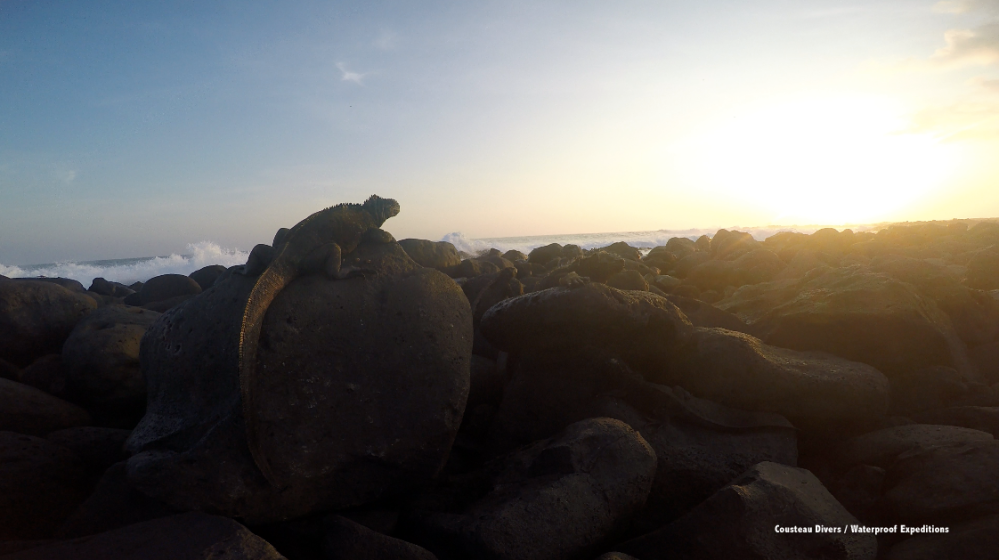
Seven sunsets later, I’ve met kind and interesting people in San Cristobal. I’ve seen sea lions crash salsa lessons and marine iguanas basking on black rocks, spitting seawater from their nostrils. I spoke to the students of San Francisco University about marine conservation issues and a small group stayed afterwards to discuss possible solutions out of the mess we’re in. Dying oceans… a collateral damage of our materialistic hypnosis. The silver bullet, if there is one, may reside in cultural and technological innovation. We also discuss bottom-up conservation and the empowerment of local communities to manage their resources, the decentralisation of environmental decision-making. It is inspiring to see an enthusiastic and energetic young generation, motivated to make the world a better place.
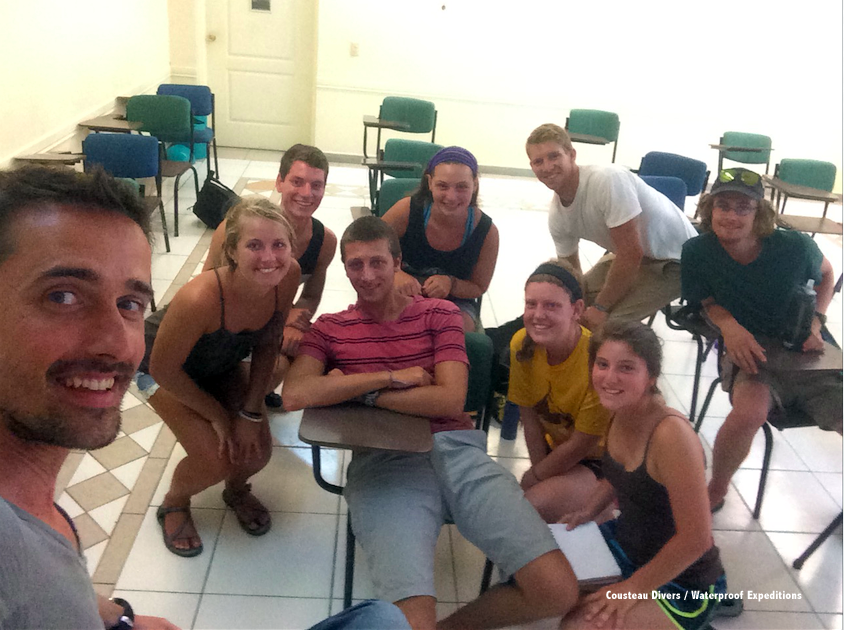
Finally, I board the Galapagos Sky again and I meet the new passengers of this second expedition. They are mostly Indians from Bombay, from a variety of professional backgrounds, but also an English mathematician and banker couple and an American physicist with his retired army friend. Discussions on board range from spirituality and shamanism to quantum physics. New questions arise from our discussions… How can behavioral change be fostered in emerging economies, based on lessons learned from western countries? How can environmental stewardship compete for brain bandwidth, using the phenomenal behavioral conditioning machinery that is advertising and marketing. One day perhaps, faced with environmental emergency, mankind will use the powerful tools that created the problem to steer the ship.
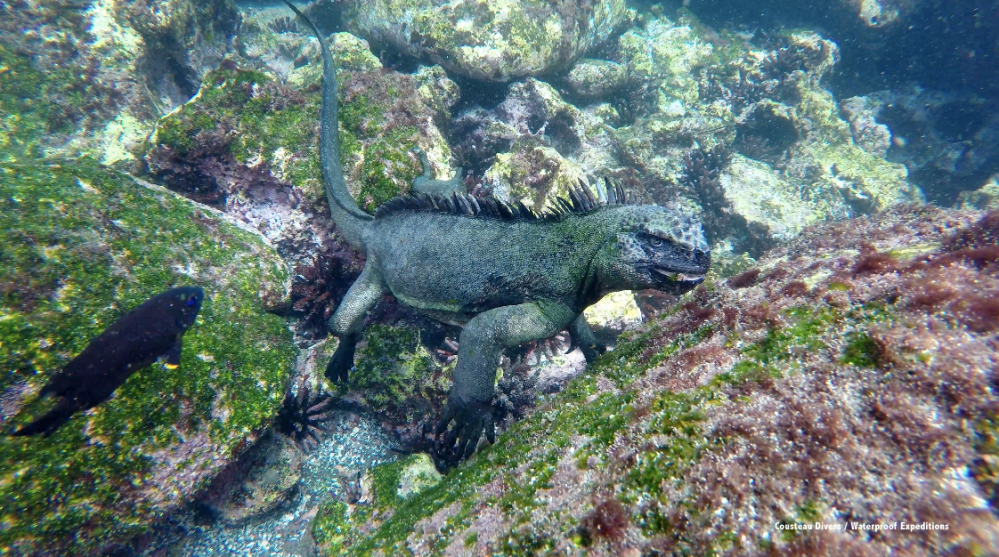
A few days later, we are diving again, in what I now feel is the richest, most extraordinary dive site in the world. Every instant of each dive in the Galapagos Islands, my attention is captured by some agitation of their untamed ecosystem. Everywhere around me, life is lush and surprising.
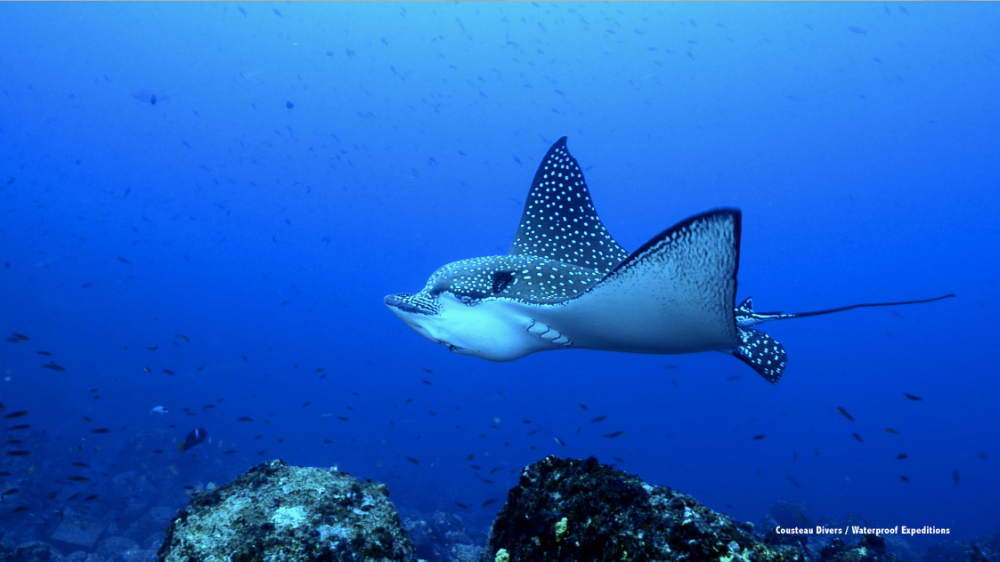
Near the island of Fernandina, the sea’s surface is littered with scavenging marine iguanas, breathing turtles and sunbathing sea lions. I befriend a puffer fish that follows me during a whole dive. A whale exhales in the distance.
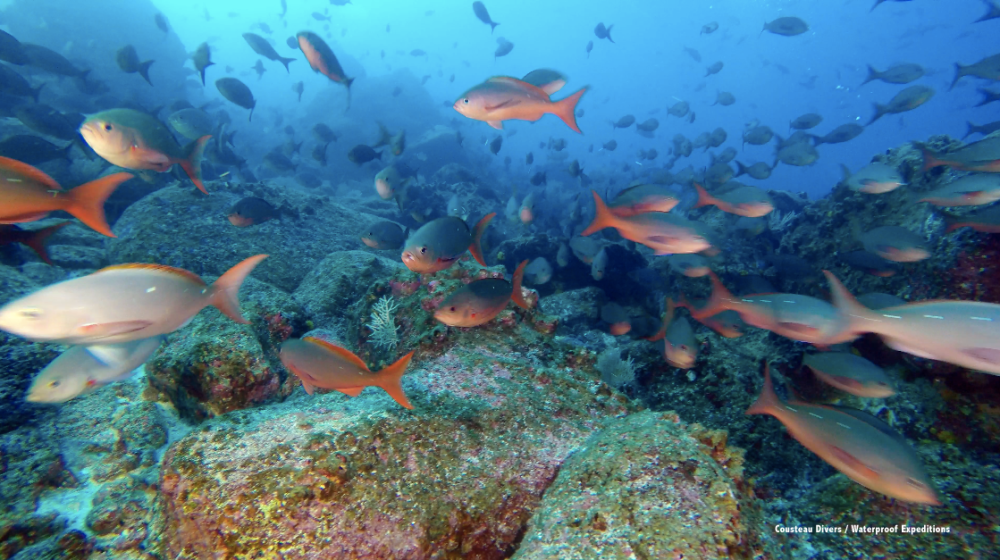
In Isabella, sea lions follow in my blind spot to use the video lights to hunt. One of them photo-bombs a test-shot: I did not see it for the whole dive, but discover it in one of my pictures… In Bartolome, I lose orientation as I enter a cloud of dozens of Mobula rays, feeling as though I am one of them.
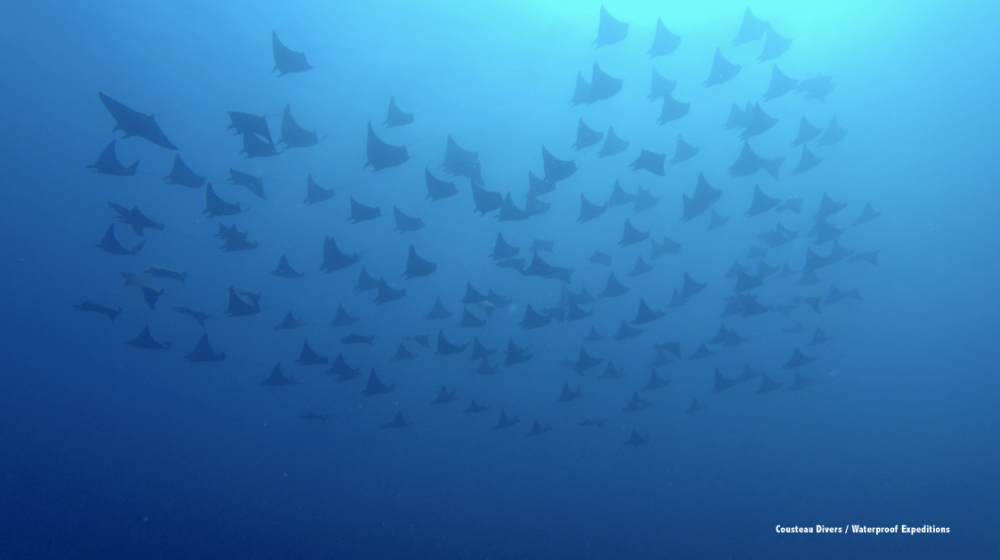
Back in Wolf and Darwin, rivers of fish flow along the rocky seascape against the current. Two white-tip sharks engage in a circular mating dance, the male biting down regularly on the female’s pectoral fins. Out of the deep blue, a group of hammerheads daringly approach me and scatter as soon as I can no longer hold my bubbles… Returning from the dives, dolphins play in the bow of our dingy.
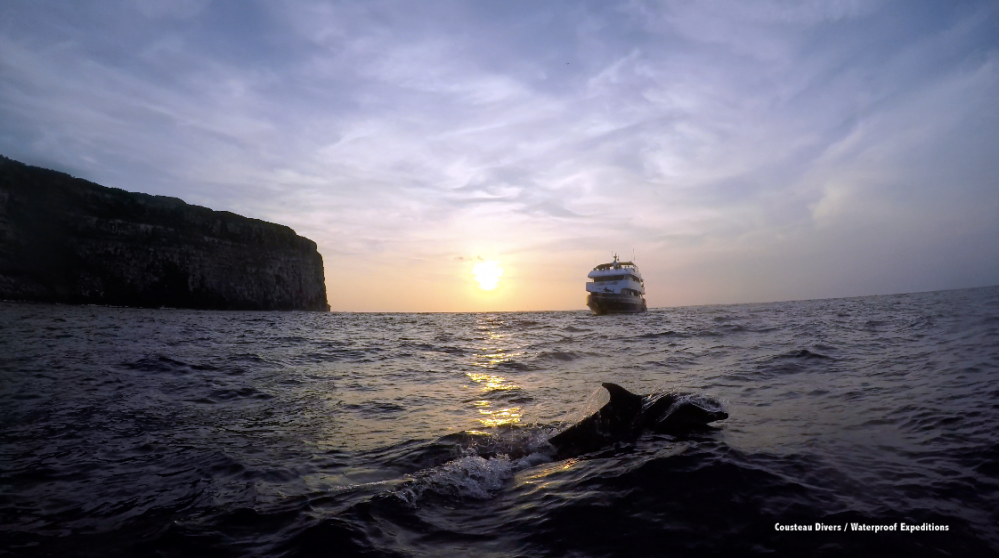
Temperatures varied greatly from site to site, from 19 to 28 degrees Celsius, and again I collected them using the Sensus Ultra and my dive computer as part of Project Hermes. The currents had greatly reduced since the last trip, and overall temperatures were a couple degrees lower. The El-Niño phenomenon seems to be receding here, just as corals begin to bleach on the other side of the planet, in Northern Australia. I leave the Sensus recording device with our guide Jeff, who agrees to using it on his dives year-round, which will provide a more comprehensive data set. This is the first of thirty locations to receive the temperature logger across the world.

Just as I am zipping up my wetsuit and slipping into my BCD for the next dive, I spot a tiny ship approaching the Sky. Manned by two, it is a fishing craft. The captain hails them. They are perhaps the first poachers of the sanctuary, barely a week after it’s declaration. I can hardly believe the effort they have put into reaching these islands: on their minuscule vessel, they must have sailed for 3 days non-stop in the open sea to reach Wolf, the deck of their boat covered in gasoline containers. The captain tells them that they are not allowed here anymore. They reply that they know, but that their engine broke and that they drifted into the sanctuary… Sure. Today there are only 5 diving operators authorized in the sanctuary, taking turns. That means that at least 2 days a week there is nobody around to report illegal fishing. Our dive guide Jeff says that at least the presence of traditional fishermen dissuaded illegal poachers to enter in the past. The captain of the Sky argues that “traditional” fishermen were sometimes collaborating with poachers.

It seems that despite significant efforts to build consensus and help fishermen reconvert to tourism activities, the actual enforcement of the newly minted Wolf and Darwin sanctuary will be difficult. Let’s hope it’s not another “protection only on paper” and that a new socio-economic balance will be found that allows for meaningful conservation of this precious jewel of the ocean, one of the few remaining.
This concludes the story of the 2016 Cousteau Divers – Waterproof Expeditions Galapagos trip. I leave the islands and return to Europe to pursue my work with IUCN and Cousteau Divers. In the coming weeks, I will release a video compiling the most thrilling moments of the trip. Join me on the next adventure to Tahiti, in July 2017!
~ Pierre-Yves Cousteau
www.waterproof-expeditions.com
For more blogs from Pierre-Yves Cousteau, visit cousteaudivers.wordpress.com.
Marine Life & Conservation
Paul Watson Released as Denmark Blocks Japan’s Extradition Bid

Renowned anti-whaling activist Paul Watson has been released from custody in Greenland after spending five months in detention. Denmark’s Justice Ministry rejected Japan’s request for his extradition, citing insufficient guarantees that his time already served in custody would be credited against any potential sentence.
The 74-year-old Canadian-American was arrested on July 21 in Nuuk, Greenland’s capital, when his ship docked to refuel. His arrest was based on a 2012 Japanese warrant related to a 2010 encounter in Antarctic waters. Japan alleged Watson obstructed operations and caused damage to a whaling research ship during efforts to disrupt illegal whaling. Watson has consistently denied these claims, maintaining his commitment to marine conservation.
Denmark, which oversees extradition matters for Greenland, concluded that while the legal conditions for extradition were met, the lack of assurances from Japan regarding time-served credit made extradition untenable.
In a video shared by his foundation, Watson expressed gratitude and relief, saying, “After five months, it’s good to be out… and good to know they’re not sending me to Japan.” He added that the most difficult part of his time in custody was being separated from his two young sons.
Watson is a pioneering figure in marine conservation, known for founding the Captain Paul Watson Foundation in 2022 after decades of activism with the Sea Shepherd Conservation Society. His bold efforts to defend marine life have earned him widespread support, including from celebrities and conservationists. His work has also been featured in the acclaimed reality TV series Whale Wars.
Watson’s lawyer, Jonas Christoffersen, praised the decision, stating, “We are happy and relieved that Paul Watson is now free.” He added that Watson is eager to reunite with his family and continue his vital work.
The arrest occurred while Watson’s vessel, the M/Y John Paul DeJoria, was en route to the North Pacific with a team of 26 volunteers to intercept a Japanese whaling ship. His foundation described the arrest as politically motivated and emphasized that Watson’s actions were focused on ending illegal whaling practices.
Japan resumed commercial whaling in 2019 after leaving the International Whaling Commission, asserting that whale meat is a cultural tradition. Conservationists, however, continue to challenge these practices, highlighting their impact on marine ecosystems.
Despite the challenges, Watson remains steadfast in his mission to protect marine life and bring attention to whaling practices. His dedication to ocean conservation has made him a globally respected advocate for the environment.
Marine Life & Conservation
12 Days of Zero-Waste Fish-mas

This holiday period, the Marine Conservation Society, the UK’s leading ocean membership charity, invites you to make some simple changes to eating fish this Christmas to help our seas.
Dr Kenneth Bodles, Head of Fisheries and Aquaculture at the Marine Conservation Society, said, “During the festive season, our consumption increases, but so does waste. Sustainability isn’t just about where food comes from – it’s also about how you use it. By reducing waste and making the most out of your seafood, you’re not only taking steps to be more ocean-friendly, but can also help to cut costs during what is often one of the most expensive times of the year”.
The Marine Conservation Society has compiled twelve tips on how to consume seafood sustainably with zero-waste this Christmas:
Buy whole fish instead of fillets
Instead of fillets, consider buying whole fish such as salmon, hake, or lemon sole. By adopting a “nose to tail” approach with cooking, whole-baked fish not only feeds a crowd, but also helps to minimise waste and maximise sustainability by using up every part of the animal, including bones, skin, and fat.
Make fish stock
Leftover fish bones or shells can be put to good use by boiling them to make a nourishing fish stock or bisque. This can be frozen and preserved for later use and makes for a flavourful base in a soup.
Make your own fish pâté
Avoid waste by turning leftover fish, such as smoked mackerel or salmon, into a delicious pâté by blending with cream cheese and lemon. Perfect when paired with crackers.
The sustainability of salmon and mackerel varies depending on where and how it is caught or farmed. For more information on green-rated options, check the charity’s Good Fish Guide.
Buy frozen
By purchasing seafood that is frozen or vacuum-packed, this helps to reduce waste by extending the shelf life of your food.
Fish pie
If you’re wondering what to do with leftover cooked fish, why not opt for a classic fish pie with mashed potatoes, leeks, and a cheesy sauce? A sure crowd pleaser on Boxing Day.
Use the head
Don’t forget the fish head! The meat is incredibly tender and flavourful. The charity recommends a cod’s head curry or recreating Fallow’s renowned cod’s head in siracha butter.
By stretching your ingredients further, not only is this a more sustainable way to enjoy seafood, but also cost-effective by repurposing leftovers and cooking creatively.
Boxing Day brunch
Mix leftover kippers or smoked salmon with scrambled eggs for a tasty, zero-waste, Boxing Day brunch.
For best choice, make sure you buy kippers, or herring, from the North Sea and the North Irish Sea.
Zero-waste storage
A top tip from the Marine Conservation Society to avoid waste is freezing fish offcuts to save for future use.
Crisp up the skin
Even leftover fish skin can be turned into a quick savoury snack by crisping it up in an air fryer with a little olive oil and salt.
Anchovies two ways
Leftover anchovies can either be blended with butter to make a delicious anchovy butter or tossed into pasta for a hit of umami flavour.
The charity recommends opting for anchovies caught in the Bay of Biscay for best choice.
Fishcakes
For an easy, zero-waste meal, leftover seafood trimmings can be mixed with mash and fried in breadcrumbs to make fishcakes.
Pickled mussels
Try pickling mussels in 1:1 vinegar and water, with a dash of sugar for a sustainable, zero-waste snack that can be enjoyed well beyond the festive season.
Mussels farmed in the UK are a seafood superhero. Grown using low-impact methods and harvested by hand, they get all the food they need from the sea around them. This makes them one of the most sustainable, ocean-friendly, and cost-effective seafood options.
Players of People’s Postcode Lottery have raised £6.6M towards the Marine Conservation Society’s vital work in making seafood more sustainable.
Laura Chow, Head of Charities at People’s Postcode Lottery, said: “Fish is a festive favourite for many, but making sustainable choices when it comes to how we buy and eat seafood makes all the difference for our ocean. Support from players of People’s Postcode Lottery has helped the Marine Conservation Society further its sustainable seafood work, so that we can all enjoy healthier, better protected seas.”
The Marine Conservation Society encourages you to make sustainable seafood choices a year-round habit, not just for Christmas. To check how sustainable the seafood on your plate is, you can visit the charity’s Good Fish Guide. The Guide helps consumers and businesses identify the most sustainable seafood using a simple traffic light system, based on where and how species are caught or farmed. Green is the best choice, amber means improvements are needed, and red indicates fish to avoid buying.
Zero-waste gift idea
Why not embrace a zero-waste Christmas by gifting a membership to support marine conservation? It’s a meaningful, low-waste gift that helps protect our ocean for generations to come. Memberships start from as little as £5 a month – the price of a sandwich and drink from your local coffee shop.
Find the latest sustainable seafood advice for wild-caught and farmed seafood on the Good Fish Guide, downloadable to your phone from www.mcsuk.org/goodfishguide.
-

 News2 months ago
News2 months agoIconic SS United States to become the World’s Largest Artificial Reef
-

 News3 months ago
News3 months agoBook Review – 52 Assignments: Underwater Photography
-

 Gear News3 months ago
Gear News3 months agoDYNAMICNORD – New German diving brand enters the British market
-

 News3 months ago
News3 months agoExploring Cenote El Pit: A Diver’s Dream
-

 Gear News3 months ago
Gear News3 months agoTry BARE drysuits (and maybe even win one!) this Friday with Sea & Sea at North West Dive Fest
-

 Marine Life & Conservation3 months ago
Marine Life & Conservation3 months agoBook Review: Coral Triangle Cameos
-

 Blogs2 months ago
Blogs2 months agoDive the Egyptian Red Sea this Autumn with Regaldive
-

 News3 months ago
News3 months ago2024 Ocean Art Underwater Photo Competition Announced



